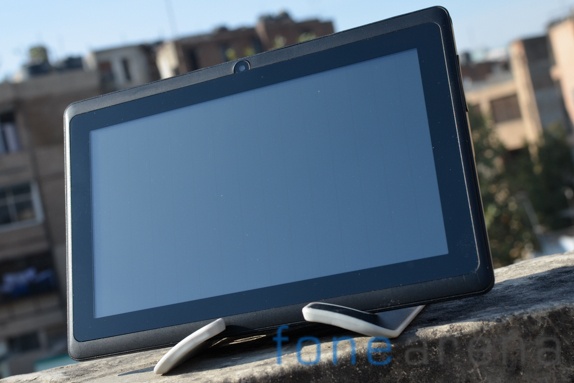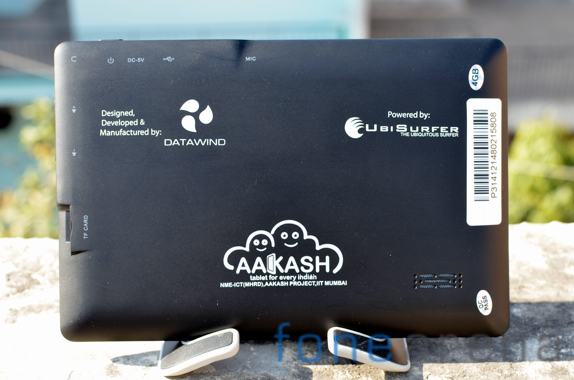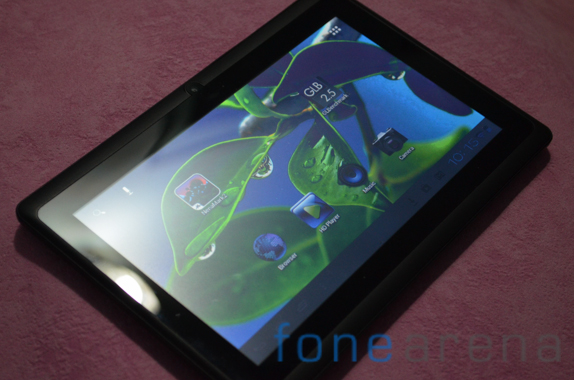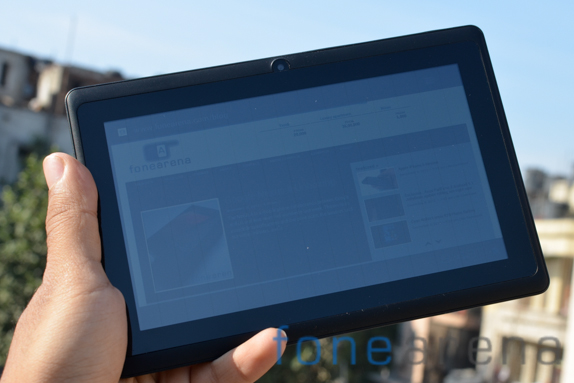The dream project of the Indian government and a poster child for bringing affordable computing to the masses, the Aakash tablet has been under the media spotlight for reasons good and bad.

The first incarnation of the tablet was an unmitigated disaster but instead of giving up, Datawind has gone back to the drawing board to come up with a brand new product with renewed internals. Is the tablet worth looking at this time around or should we give it a pass ? Read on to find out.
Unboxing
The in-box contents of the Aakash / Ubislate 7Ci are fairly spartan but do cover the essentials. You can find a power adaptor, micro USB port and a USB OTG cable. Check out the video below for more details.
httpv://youtu.be/Yx_aD6OYPpw
Hardware
The Aakash tablet is a fairly solid piece of kit and provides a surprisingly robust tablet for the price. The hardware feels relatively solid though we could feel the plastic flex under pressure.
The front has a bright but not too vibrant 7″ capacitive multitouch display. The resolution here is 800×480 which is decidedly low. Above it you can find a front facing 0.3MP camera. The camera is perhaps the worst we’ve used with an astonishing level of noise in the images coupled with severe color degradation.
The back of the tablet is bereft of a camera module to keep the prices in check. Our unit had silkscreened labels for Datawind, Ubisurfer and Aakash. We’re guessing this will be toned down in the Ubislate variant of the tablet.
A speaker grille can be found in the bottom right corner. The speaker is sufficiently loud for personal listening but don’t expect to blast music from it at your next party.
The Ubislate 7Ci does’t offer anything extraordinary in the name of ports. You’ll find a microUSB port and 2.5mm charging pin slot to the left of the power key.
Over on the right hand side lies the volume rocker and 3.5mm jack. A microSD based expansion slot lies further below the volume rocker and serves well to expand the 4GB of inbuilt memory on the tablet.
Screen
The 7 inch capacitive multi-touch enabled display is definitely not the worst that we’ve seen but is far from ideal.
For a tablet which is expected to be a revolution in the education sector, the low resolution isn’t very conducive to reading text. 800×480 is positively ancient by today’s standard and while we weren’t expecting a retina panel for sure, we would have liked to see WSVGA / XGA support.
The screen on the Aakash tablet is sufficiently bright and we were able to view on screen contents as long as we stayed out of direct sunlight. Unfortunately the colors and more so the viewing angles are utterly disappointing. Looking at the tablet anything other than straight-on results in severe color degradation. This means that it is nigh impossible for two people to view content on the Ubislate simultaneously.
Software
The mark of a great product is the perfect blend of good hardware and compelling software. Does the Aakash tablet deliver ? Not really.

The tablet is powered by Android 4.0.4 ie Ice Cream Sandwich. The software is well optimized for the modest internals of the tablet and works well. Lags while navigating the interface are few and far between. The tablet would definitely benefit from performance improvements brought by Jelly Bean but we wouldn’t hold out for an update.

Where Datawind has missed an opportunity is in providing compelling education oriented software which is surprising considering that their primary audience needs exactly that. You get a plain build of Android with custom icons and a few apps like HD Video Player and an app for The Financial Times.
Performance
Taken out of context, the Aakash tablet scores thoroughly unimpressive results in performance benchmarks. However, we’re talking about an ultra affordable tablet here and the fact that it can keep up with offerings at almost double the price point speaks volumes. The ARM 11 Cortex A8 processor clocked at 1000 MHz coupled with 512MB of RAM is just about sufficient to keep things running smooth.

As can be with the Quadrant results, the Aakash is not going to break any performance records but it sure can come close to its contemporaries. The Quadrant benchmark is an all round test which gives us a cumulative score by comparing CPU, I/O and 3D graphics performance.

Like Quadrant, AnTuTu scores too show us what we already know. The tablet can keep up with other entry level models thanks to a combination of good enough specs and an undemanding WVGA screen.
The Linpack test is used to benchmark the floating point operations per second. Once again, the Aakash 2 just about keeps up with competitors like the Micromax Funbook and actually scores higher than the Funbook Pro. Over all the tablet remains useable in almost all circumstances but don’t expect to play the latest and greatest games on it. It will struggle with any processor intensive task as we couldn’t even get it to play videos any higher than WVGA.
Battery Life
The battery life on the Aakash 2 tablet is a mixed bag. While the standby time is pretty decent, we usually clocked about 3-3.5 hours of usage time on the tablet. The 3,000 mAh Li-Pol battery won’t work any miracles and there’s no way you can expect all day computing from this device which to some extent defeats the purpose of using this in the education segment.
Conclusion
There’s no doubt that the Ubislate 7Ci is much better than the disappointing first generation product but we’re not too sure it’ll solve the problems it was meant to. The tablet has too low a resolution to be useful while reading high graphic PDFs.
The battery life too is just not sufficient for a regular day of usage. The anemic processor just about pulls through the UI but demanding applications will bring everything grinding to a halt. The lack of education oriented applications also throws a spanner in the government’s plans to revolutionize education in India. However its not all bad news for the tablet as it does manage to bring a decently built product at a great price point. The Aakash 2 / Ubislate 7Ci is being subsidized by the government and will be sold for Rs. 1,130. The regular unsubsidized varient is priced at Rs. 4,499.
Pros
- Decent build quality
- Well optimized software
Cons
- Poor battery life
- WVGA display










